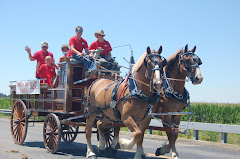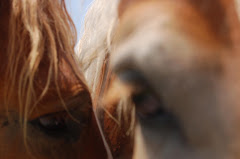

As you can tell if you've read this blog, we are draft horse enthusiasts here at the Arthur Veterinary Clinic. I was raised with Belgians on a farm near Arcadia, Indiana.  Dr. Linda breeds and shows Clydesdales and Dr. Scott and his brother, Gary (my husband) have bred and shown Clydesdales, Percherons and Belgians.
Dr. Linda breeds and shows Clydesdales and Dr. Scott and his brother, Gary (my husband) have bred and shown Clydesdales, Percherons and Belgians.  The Arthur Veterinary Clinic has a large client base of draft horse owners.
The Arthur Veterinary Clinic has a large client base of draft horse owners.
 Dr. Linda breeds and shows Clydesdales and Dr. Scott and his brother, Gary (my husband) have bred and shown Clydesdales, Percherons and Belgians.
Dr. Linda breeds and shows Clydesdales and Dr. Scott and his brother, Gary (my husband) have bred and shown Clydesdales, Percherons and Belgians.  The Arthur Veterinary Clinic has a large client base of draft horse owners.
The Arthur Veterinary Clinic has a large client base of draft horse owners.

August and September are busy months if you show draft horses since many state fairs in the Midwest have large draft horse shows. And, the Indiana State Fair has one of the largest. On a personal note, I have just returned from spending 15 days at the Indiana State Fair helping run the draft horse show. I am the third generation of Ellers to be on the show committee. My grandfather, my father and my brother have all been involved with the show continuously since the 1950s. And, my other brother has been an announcer and I have two nephews which also help with the show.
The five major breeds which make of draft horses are Belgians, Percherons, Clydesdales, Shires and Suffolks. I will limit this discussion to Belgians, Percherons and Clydesdales which each have their individual breed registries. This blog will focus on Belgians and I will follow up with Percherons and Clydesdales on the next blog.

The draft breeds originated from Europe. They are known for their gentle disposition and drafty size which allows them to excel at farm work, pull large wagons and freight. With the advent of mechanization after World War II and the introduction of the small, rubber tired tractor, the draft breed numbers declined significantly. However, over the decades, long time breeders have persisted despite the use of tractors. Other equine lovers discovered the usefulness of the draft horse, using them on non-farm tasks. Horse shows and state fairs began to welcome the gentle giants and the draft horse industry has continued to flourish. Artificial insemination, cooled transported semen and embryo transfer are used frequently in draft horse breeding.
While the majority of draft horses are located in the Midwest and east central Canada, they are popular throughout the US. A major driving force behind the draft horse industry are the draft horse shows. A draft horse show usually consists of two parts: the halter or conformation classes for purebred draft horses and the hitch or performance classes. Most large shows have separate classes for each breed while the smaller shows and county fairs may combine all breeds in a class.
Halter classes are shown by age....for example, all the yearling mares will compete against each other. Typically, the show will crown a junior champion stallion and mare (2 years and under) and a senior champion stallion and mare (3 years and over). From these winners a Grand Champion mare and a Grand Champion stallion will be awarded. Most shows then go on to choose a Best of Breed.

Hitch classes involved horses in harness pulling either a show cart or a wagon. A show cart is usually pulled by one horse, whereas the classes pulling a wagon are teams, unicorns (three horses), four and six. Occasionally, an event will host an eight horse hitch class. Over the years, geldings have been commonly used in the hitch classes. However, the last 10-15 years has seen an increase in the number of all mare hitches which has resulted in separate classes for gelding hitches and mare hitches. If you have never been to a draft horse show, I encourage you to attend a hitch show. Watching these hitches thunder around a ring, decked out in show harness and a show wagon will give you goose bumps.....I guarantee it!!!
Halter classes are shown by age....for example, all the yearling mares will compete against each other. Typically, the show will crown a junior champion stallion and mare (2 years and under) and a senior champion stallion and mare (3 years and over). From these winners a Grand Champion mare and a Grand Champion stallion will be awarded. Most shows then go on to choose a Best of Breed.

Hitch classes involved horses in harness pulling either a show cart or a wagon. A show cart is usually pulled by one horse, whereas the classes pulling a wagon are teams, unicorns (three horses), four and six. Occasionally, an event will host an eight horse hitch class. Over the years, geldings have been commonly used in the hitch classes. However, the last 10-15 years has seen an increase in the number of all mare hitches which has resulted in separate classes for gelding hitches and mare hitches. If you have never been to a draft horse show, I encourage you to attend a hitch show. Watching these hitches thunder around a ring, decked out in show harness and a show wagon will give you goose bumps.....I guarantee it!!!


Belgians
The Belgian horse originated from the country of Belgium. Belgians are typically sorrel colored with a light or white mane and tail, varying amounts of white on their legs and a stripe on their forehead. They can also be blonde or chestnut. Today's Belgian is a big, powerful horse that retains the drafty middle, a deep, strong foot, a lot of bone, the heavy muscling and amiable disposition possessed by the early Belgians. His qualities as an easy keeper and a willing worker make the Belgian a favorite. The modern Belgian possesses an animated gait and hitch horses must be up headed and high stepping. At this time, Belgians outnumber all the other draft breeds combined.
The is a picture of Dr. Scott and Gary showing the first place aged yeld mare at the NABC VI. Notice that Dr. Scott is on the lead and Gary is the whipman. When the horse is lead before the judge in a halter class, the whipman trails the horse. In this picture, he is seen in front of the horse to help with the headset when standing before the judge. In halter classes, mares have their tails tied up but not their manes braided. Stallions and geldings have their tails tied up and their manes braided with rosettes. Mares manes are braided for hitch classes.


A winning eight horse hitch


A "sea" of hitch horses. 
The six horse hitch class at the NABC VI
Indiana State Fairgrounds
Men's Cart Class at the NABC VI
Four Abreast Class at the NABC VI. This is a very exciting class!
Here is a video of a an eight horse hitch class
Next blog, I will discuss Percherons and Clydesdales.....plus have more great pictures! Thanks to Kelly Woodbury for letting me use some of her pictures from the shows!.










